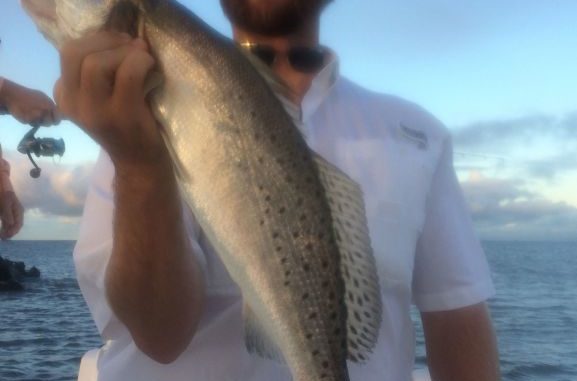
Target first trough for solid trout — but be extra patient on hookset, guide says
If you’ve never experienced the absolute fun of fishing live croakers in the surf for Grand Isle specks, July is a great month to cross that trip off your bucket list.
Capt. Keith “Herk” Bergeron, with Pair-A-Dice Charters on the island, said that no matter if you’re fishing from a boat or on foot from the beach, target that first trough early on hot July mornings.
“A lot of people wade-fishing get out in the water and walk out to the sandbar and get neck-deep in the water, and they’re passing up all the trout,” he said. “The fish are in that first trough … I think they’re actually catching that bait as it’s in that turbulent water on the back side of the breaking waves.
“The baitfish gets disoriented as to where it’s at, and those big trout are riding the waves catching them.”
Bergeron typically anchors his boat in about 4 feet of water, and uses Carolina rigs with heavy weights to make it easier for his customers to reach the strike zone in the first trough.
“I use a ½- to ¾-ounce weight, and I fish with 40-pound test mono on an 18-inch leader and a No. 10 swivel with a 3/0 Kahle hook,” he said. “If your leader is any longer than that, I find that croaker has too much area to swim before you feel the bite.
“As soon as that fish hits, you’re going to know. And I fish with 20-pound braided line, so there’s no stretch at all.”
Bergeron said the bite typically lasts only until about 9 or 10 a.m., so time is of the essence. That means making the most of every cast with your croaker, which can admittedly be tough to do if you’ve never felt the intense thump of a big speck slamming what it thinks is an easy meal.
Patience on the hookset is absolutely vital, he said.
“Even if you have a good bass fisherman, it’s hard for them to relax and let the trout actually take the croaker,” Bergeron explained. “I find the first strike you feel is the trout actually killing the croaker when they hit it — then they start swallowing it and running with it.
“If you don’t let 5 seconds go after you feel the bite, you’re going to miss them. Sometimes I even put the rod in the rod holder and have them wait until it starts bending over.”
Bergeron said he hooks his croakers in the back, about 1 ½ inches from the tail.
“Stay away from their internal organs as best you can because if you hook them in the gut or on top of the head, it makes them start bleeding inside and they die quick,” he said. “If you get three casts out of a croaker, that’s pretty good. Once the croaker gets lethargic and barely swims, the trout won’t even hit them. They have to be in a frenzy to bite.”
Along Elmer’s Island, the rocks at Grand Isle State Park and the Grand Terre beach are all spots Bergeron likes to target in July. The good news is the guide isn’t catching schoolies in the surf.
“The trout are always bigger at the end of April, because everybody is just starting to fish and they’re catching the bigger fish,” he said. “But we’re still going to run into some 3s and 4s, and possibly a 5 here and there.”